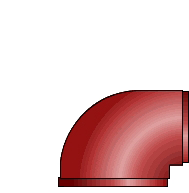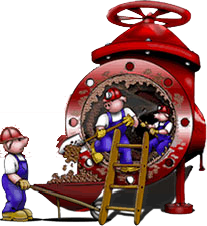Piping systems that deliver potable water may have another primary and equally important function, i.e., the supply of water adequate in volume and pressure to provide for proper and safe fire protection including meeting the demands of specialty firefighting equipment.
The usual methods used to externally determine the interior condition of a dual function piping system, (potable water supply and fire protection), include recording consumer complaints about odors, colors, tastes and minimal pressures of the delivered water and evaluating the maintenance of required disinfecting residuals in the system. Perhaps the most telling and accurate means to measure the volume capacity of the piping is to flow the connecting hydrants using the butt connections and record the volume being discharged. Once documented by field measurements of the residual, (flowing), flows and checking the size of the hydrant butt connection then the volume of flow can be checked and correlated with the chart of fire flows long established by the fire insurance industry. See enclosed copy of this chart. For example, flow for fire protection using a butt connection of 2.5 inch inside diameter at 20 PSI equates to 750 gallons per minute. NOTE: This volume is the lowest acceptable amount for minimal fire protection.
When the connecting main is cleaned and restored to its maximum flow capacity, the usual result is that there is a significant increase in the volume capacity of the system, sometimes as much as 300-400 percent and a consequential reduction in the residual or flowing pressure in the main.
Before and after flow measurements taken from the connecting hydrants usually reflect these improvements to the system as a whole.
However, if the piping connecting the hydrants to the main is not cleaned and remains in its original dirty and reduced flow capacity then the improvements to flow accomplished by cleaning the main will not be reflected in the flow capacity of the hydrant. Therefore Professional Piping Services strongly recommends that cleaning the hydrant leg piping be incorporated into the overall system cleaning plan.
Further advantages to cleaning hydrant leg piping are;
- Provides the opportunity to remove old, ineffective, on their last operating legs, constantly needing maintenance and repairs and antique hydrants and replace them.
- Allows for relocation of the hydrant, adding a valve or supplementing thrust blocks.
- Can possibly provide an exiting or entering site for cleaning and possibly eliminating the need for fitting insertion in difficult or awkward places.
- As hydrants are dismantled for cleaning purposes the need for old and scarce gaskets, bolts, valves, stems, etc., can be eliminated.
- In many applications one cut and one coupling are all that is needed to effect the change of old hydrants to new ones.
- Finally, cleaning hydrant leg piping can maximize the return for the investment in time, efforts and funding.
Certified Underground Utility Contractor
License Number CU-C057357
License Number CU-C057357



